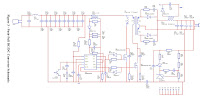
Introduction
This report describes the design of a 320W Telecoms DC/DC converter. A push-pull forward
converter running with current mode control using the LM5030 from National Semiconductor
delivers high performance and small solution size. Custom planar magnetics from Payton
have been used throughout to reduce component build height, increase efficiency and aid
cooling.
This report contains target specification, schematic, bill of materials, magnetics design
information as well as a detailed design analysis. A full set of performance measurements is
also included taken from the prototype unit shown in Figure 1. Measurements include
conversion efficiency, power stage device temperature rise, line/load regulation, start-up
behaviour, transient load response and loop gain/phase characteristic.



































 JOSIL ARTISTA PLASTICO FORTALEZA CEARA BRASIL AV.HERACLITO GRAÇA 41 TEL(85)32542378
JOSIL ARTISTA PLASTICO FORTALEZA CEARA BRASIL AV.HERACLITO GRAÇA 41 TEL(85)32542378















